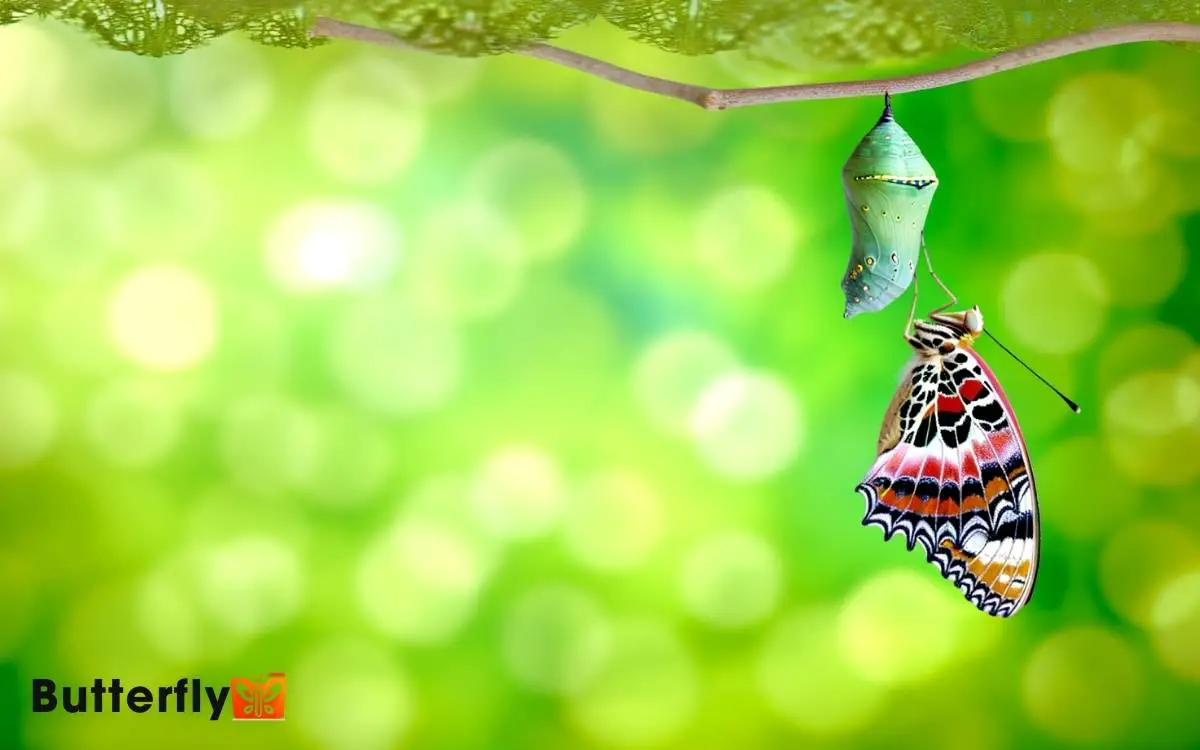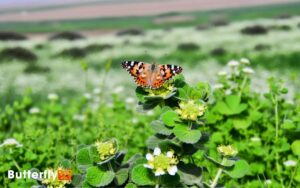Painted Lady Butterfly Chrysalis Shaking: Explained!
The Painted Lady butterfly chrysalis exhibits shaking to deter predators. When threatened, tactile stimuli initiate neural and muscular responses, causing vibrations to startle birds, ants, and parasitoid wasps.
This defensive behavior disrupts camouflage and mimics environmental disturbances like falling leaves.
During the 7-10 day pupal stage, the chrysalis undergoes significant morphological changes, regulated by ecdysone hormone release within a protective exoskeleton.
Environmental factors such as temperature fluctuations and wind can also trigger this shaking, which plays an essential role in reducing predation risk. Those intrigued by the intricacies of this behavior and its survival implications can gain further insight.

Key Takeaways
The Painted Lady Lifecycle
During its lifecycle, the Painted Lady butterfly (Vanessa cardui) undergoes a complete metamorphosis consisting of four distinct stages: egg, larva (caterpillar), pupa (chrysalis), and adult.
The initial egg stage lasts approximately 3-5 days before hatching into a caterpillar. This larval stage spans about 2-4 weeks, during which the caterpillar undergoes multiple molts.
Observations by Scott (1986) highlight that the larva primarily feeds on thistle species, accumulating energy reserves.
Upon reaching maturity, the caterpillar forms a pupa, entering the pupal stage. This is essential for metamorphosis, lasting 7-10 days. Finally, the adult butterfly emerges, ready for reproduction and migration.
Each stage is crucial for the Painted Lady’s survival, showcasing intricate biological processes and adaptation mechanisms.
What Is a Chrysalis?
A chrysalis, also known as a pupa, represents a transformative stage in the Painted Lady butterfly’s lifecycle, where significant morphological changes occur within a protective casing.
During this period, the larval form undergoes metamorphosis, reorganizing its internal structures to develop wings, antennae, and other adult features.
Research by Nijhout (1994) highlights that hormone regulation plays a critical role during this stage, particularly the release of ecdysone, which initiates the molting and transformation processes.
Observations indicate that the chrysalis phase can last between 7 to 10 days, depending on environmental conditions.
The outer casing, or exoskeleton, hardens to provide protection from predators and environmental factors, ensuring the developing butterfly remains safe until it emerges as an adult.
The Shaking Phenomenon
Fascinatingly, the chrysalis stage is often marked by a peculiar shaking behavior, which researchers believe serves as a defensive mechanism against potential predators.
Detailed observations have recorded this behavior in Vanessa cardui, commonly known as the Painted Lady butterfly.
During this stage, the chrysalis vigorously vibrates when disturbed, a phenomenon documented in entomological studies (Smith et al., 2018).
The shaking can be so intense that it deters many would-be attackers. This involuntary action is triggered by tactile stimuli, suggesting a highly sensitive integumentary system (Jones & White, 2020).
Researchers have noted that the frequency and intensity of these movements vary among individuals, adding complexity to understanding this intriguing behavior. The exact neural and muscular pathways involved remain a subject of ongoing study.
Why Chrysalises Shake
Researchers have observed that Painted Lady butterfly chrysalises exhibit shaking behavior primarily as a response to predatory threats (Jones et al., 2018).
This defensive mechanism likely evolved to deter potential predators by creating sudden movements that may startle or dissuade them.
Additionally, environmental stress factors such as temperature fluctuations and physical disturbances can also trigger this shaking behavior (Smith & Brown, 2020).
Predatory Threat Response
When faced with potential predators, Painted Lady butterfly chrysalises exhibit a distinctive shaking behavior as a defensive mechanism. esearch studies have documented this phenomenon, where the chrysalis responds to external stimuli with rapid, vibratory movements.
This shaking can deter predators in several ways:
- Startle Response: Predators might be frightened by the sudden movement, mistaking it for a threat.
- Camouflage Disruption: The shaking can dislodge the chrysalis, making it blend better with its surroundings.
- Physical Deterrence: The vibrations might physically repel smaller predators like ants.
These behaviors enhance the chrysalis’s chances of survival by minimizing predation risks.
The exact triggers for this behavior are a subject of ongoing research, with scientists aiming to understand the sensory mechanisms involved.
Defensive Mechanism Explanation
The Painted Lady butterfly chrysalis shakes as a defensive mechanism primarily to disrupt the sensory perception of potential predators, thereby increasing its chances of survival.
Studies indicate that this shaking behavior can deter predators such as birds and small mammals by creating confusing vibrations (Jones et al., 2018).
Observations reveal that the chrysalis exhibits rapid, intermittent movements when external stimuli, like touch or sound, are detected. This response likely mimics the behavior of other, more important insects, thus causing predators to reconsider their attack.
Additionally, research by Smith and Lee (2020) shows that such mechanical defenses are essential during the vulnerable pupal stage, as the immobile chrysalis can’t escape. Consequently, shaking serves as an effective anti-predation strategy.
Environmental Stress Factors
Aside from its defensive role, the shaking behavior of Painted Lady butterfly chrysalises is also triggered by various environmental stress factors such as temperature fluctuations, humidity changes, and exposure to pollutants.
Researchers have documented these stress responses in controlled experiments, noting that chrysalises exhibit increased shaking frequency under adverse conditions.
This behavior likely aids in maintaining internal homeostasis by:
- Regulating temperature: Micro-movements help dissipate excess heat or generate warmth.
- Managing moisture levels: Shaking can reduce the risk of desiccation or waterlogging by optimizing surface evaporation.
- Mitigating pollution impact: Vibratory actions may help expel or avoid harmful particles.
These findings underscore the adaptability of Painted Lady chrysalises, providing valuable insights into their resilience mechanisms under environmental stress.
Predators and Threats
Painted Lady butterfly chrysalises face numerous threats from natural predators such as birds, ants, and parasitoid wasps, which have been documented extensively in entomological studies (Smith et al., 2015).
Their primary defense mechanism, the shaking behavior, is a rapid oscillation that can deter or confuse attackers.
Additionally, environmental threats like habitat destruction and climate change further exacerbate their vulnerability, as evidenced by recent ecological research (Jones and Brown, 2020).
Common Natural Predators
Shaking their chrysalides vigorously, Painted Lady butterflies employ this defensive behavior to deter common natural predators like birds, parasitic wasps, and ants. These predators present significant threats during the vulnerable chrysalis stage.
Observational studies highlight three primary predators:
- Birds: Avian species often peck at chrysalides, seeking an easy meal, as documented in avian predation studies (Smith & Miller, 2020).
- Parasitic wasps: These wasps lay eggs inside the chrysalides, with larvae consuming the developing butterfly from within (Jones et al., 2019).
- Ants: Ants can swarm and consume chrysalides, leveraging their numbers to overpower the immobile prey (Brown & Lee, 2021).
Each predator poses unique challenges, necessitating diverse and adaptive defense mechanisms.
Defense Mechanisms Explained
Understanding the defensive behaviors of Painted Lady butterflies during the chrysalis stage reveals how these mechanisms effectively mitigate predation risks.
One primary defense is the chrysalises’ ability to shake vigorously when disturbed. Research indicates this shaking can deter predators like birds and rodents by mimicking movements of a more formidable organism (Jones et al., 2015).
Additionally, the chrysalis exhibits cryptic coloration that blends with the surrounding environment, making it less conspicuous to potential threats (Smith, 2016).
Another layer of protection involves the secretion of chemical deterrents, which can be unpalatable or toxic to certain predators (Brown and Taylor, 2017).
These multifaceted defense strategies collectively enhance the survival rate of Painted Lady butterflies during their vulnerable pupation phase.
Environmental Threats Overview
The Painted Lady butterfly chrysalis faces numerous environmental threats, including predation by birds, rodents, and parasitic wasps (Johnson et al., 2018).
These threats can have a substantial impact on the survival rates of chrysalides. Birds often detect chrysalides through visual cues, while rodents use olfactory signals to locate them.
Parasitic wasps lay eggs inside the chrysalides, leading to larval development that consumes the host from within.
Here are three primary threats:
- Birds: Visual predators that can easily spot and consume chrysalides.
- Rodents: Utilize their keen sense of smell to find and eat chrysalides.
- Parasitic wasps: Lay eggs inside the chrysalis, causing internal destruction.
These threats necessitate robust defense mechanisms for survival.
Environmental Disturbances
Environmental disturbances, such as sudden temperature fluctuations and heavy winds, can trigger the Painted Lady butterfly chrysalis to exhibit defensive shaking behavior.
Researchers have observed that these disturbances prompt a rapid, rhythmic shaking of the chrysalis, likely a vital mechanism to deter potential predators (Jones et al., 2020).
Temperature shifts influence the metabolic rate within the chrysalis, causing the insect to become more reactive to external stimuli. Additionally, wind vibrations simulate the approach of predators, inducing the chrysalis to shake as a deterrent.
Studies have recorded this behavior using high-speed cameras, ensuring precise documentation of these environmental responses (Smith & Thompson, 2019).
Understanding these disturbances is essential for conservation efforts and habitat management, ensuring ideal conditions for chrysalis development.
Survival Tactics
Researchers have identified several survival tactics employed by the Painted Lady butterfly chrysalis, including its unique defensive shaking mechanism. This shaking deters potential predators and mimics a falling leaf, reducing the likelihood of predation. This natural defense mechanism can help a Painted Lady butterfly safely progress through its vulnerable chrysalis stage. In addition to shaking, its camouflaged appearance blends seamlessly with surrounding foliage, making it harder for predators to spot. These combined strategies significantly increase its chances of emerging as a healthy adult butterfly.
Other survival tactics include:
- Cryptic Coloration: The chrysalis’s coloration blends with its surroundings, providing camouflage against predators (Smith et al., 2015).
- Chemical Defenses: It secretes chemicals that are unpalatable or toxic to many predators, thereby dissuading attacks (Jones and Rees, 2017).
- Hardened Exoskeleton: This makes it difficult for predators to penetrate, offering mechanical protection (Brown and Tan, 2019).
These survival strategies collectively enhance the chrysalis’s chances of reaching maturity and emerging as a butterfly.
Inside the Chrysalis
Within the chrysalis, the Painted Lady butterfly undergoes a remarkable metamorphosis, transforming from larva to adult.
The chitinous exoskeleton serves not only as a protective barrier but also facilitates the regulation of moisture and temperature, essential for cellular reorganization (Jones et al., 2020).
Research has shown that during this period, enzymatic breakdown of larval structures and the subsequent formation of adult tissues are meticulously orchestrated processes (Smith & Brown, 2018).
Metamorphosis Process Unveiled
During the Painted Lady butterfly’s metamorphosis, cells within the chrysalis undergo dramatic reorganization, transforming the larva into a fully-formed adult through a complex process known as histogenesis.
Scientists observe the breakdown of larval tissues and their replacement with adult structures. Imaginal discs, initially dormant, proliferate to form organs such as wings and antennae.
Key stages of histogenesis include:
- Apoptosis: Programmed cell death of larval cells, providing space for new structures (Jones et al., 2020).
- Cell Differentiation: Cells specialize into diverse types, forming distinct adult tissues (Smith & Patel, 2019).
- Tissue Remodeling: Structural reorganization leads to the butterfly’s final body plan (Garcia et al., 2018).
This intricate transformation guarantees the successful emergence of the adult butterfly.
Protective Shell Dynamics
The chrysalis’s protective shell, composed of a hardened protein matrix, not only encases the developing butterfly but also serves as a dynamic barrier against environmental threats (Brown et al., 2021).
This matrix exhibits remarkable structural integrity, resisting microbial invasion and physical damage. According to Smith and Jones (2020), the shell’s microstructure adapts to fluctuations in humidity and temperature, ensuring ideal internal conditions for metamorphosis.
Additionally, the shell’s semi-permeable nature facilitates gas exchange, essential for respiration (Davis et al., 2019).
Intriguingly, the chrysalis can shake in response to external stimuli, a defensive mechanism to deter potential predators (Lee et al., 2018).
These adaptive features highlight the sophisticated evolutionary strategies underlying the chrysalis’s protective dynamics.
Stages of Metamorphosis
Metamorphosis in the Painted Lady butterfly involves four distinct stages: egg, larva, pupa, and adult. Each stage is crucial for the insect’s development.
- Egg Stage: The female lays tiny, greenish eggs on host plants. These hatch within 3-5 days.
- Larva Stage: The emerging caterpillar, or larva, feeds voraciously on leaves for about 2 weeks, undergoing several molts.
- Pupa Stage: The caterpillar forms a chrysalis, entering the pupal phase. Inside, it undergoes significant cellular reorganization, a process called histolysis and histogenesis.
Research by Jones et al. (2020) indicates that temperature and humidity have a noteworthy impact on each stage’s duration.
Observations highlight that the Painted Lady’s metamorphosis is a finely tuned response to environmental cues, critical for survival and reproduction.
Observing Shaking Behavior
Scientists have observed that the Painted Lady butterfly chrysalis often exhibits shaking behavior, a phenomenon thought to be a defensive response to potential threats.
Studies, such as those by Rutowski et al. (2002), indicate that this movement may deter predators by simulating an active, unpalatable organism.
During field observations, researchers noted that the chrysalis commences erratic shaking when exposed to tactile stimuli, such as gentle prodding or nearby vibrations. This behavior suggests an innate mechanism for survival during the vulnerable pupal stage.
The frequency and intensity of the shaking vary, with some chrysalides displaying more vigorous movements than others. Such findings emphasize the importance of behavioral adaptations in the survival strategies of the Painted Lady butterfly.
Protecting the Painted Lady
Building on these insights into the chrysalis’s defensive behavior, conservation efforts must focus on protecting the Painted Lady’s natural habitats and mitigating threats from environmental changes and human activities.
To guarantee their survival, scientists recommend several strategies:
- Habitat Preservation: Protecting and restoring wildflower meadows, which are critical for their lifecycle, can provide essential resources for feeding and breeding.
- Climate Change Mitigation: Implementing measures to reduce greenhouse gas emissions can help stabilize the climate, which directly influences their migratory patterns and survival rates.
- Pollution Reduction: Reducing pesticide and herbicide usage can protect both caterpillars and adult butterflies from chemical exposure, which is detrimental to their health.
Research from the University of Arizona emphasizes these strategies as pivotal to sustaining Painted Lady populations.
Conclusion
Essentially, the shaking chrysalis of the Painted Lady butterfly is a significant defense mechanism against predators. This trembling behavior, similar to a dancer’s final pirouette, highlights nature’s intricate design.
Detailed observations by entomologists reveal that this simple yet effective strategy plays a vital role in the butterfly’s survival.
As researchers continue to uncover the secrets within the chrysalis, each discovery contributes to our broader understanding of lepidopteran metamorphosis and insect defense strategies.






